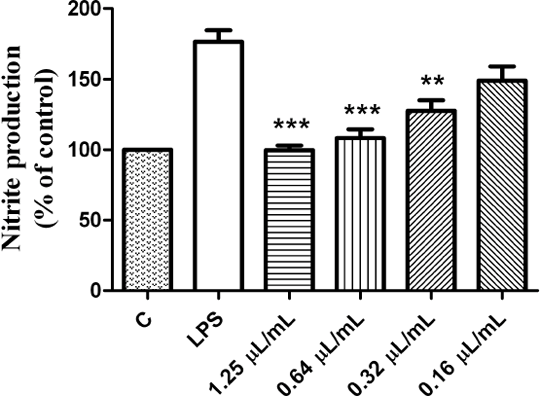Print version
Search Pub Med
Chemical composition, anti-inflammatory activity and citotoxicity of Otanthus maritimus (L.) Hoffmanns. & Link from Portugal Otanthus maritimus (L.) Hoffmanns & Link grows on maritime sands along the coasts of South and West Europe, northwards to South-East Ireland and belongs to the Asteraceae family that includes well-known aromatic and medicinal species such as chamomile, yarrow, wormwood and feverfew. The use of O. maritimus has been reported in traditional medicine for various purposes including the treatment of toothache, asthmatic bronchitis, dysentery and inflammation of the urinary bladder. The present work aimed to characterize the chemical composition of the essential oil obtained from the aerial parts of O. maritimus collected in Portugal, as well as to evaluate the anti-inflammatory activity of the oil at concentrations safe to mammalian cells. The essential oils (EO) were characterized by gas chromatography (GC) and gas chromatography–mass spectrometry (GC–MS). Assessment of cell viability was made by the 3-(4,5-dimethylthiazol-2-yl)-2,5-diphenyltetrazolium bromide (MTT) assay and the in vitro anti-inflammatory potential of Otanthus maritimus oil was evaluated by measuring nitric oxide (NO) production using lipopolysaccharide (LPS)-stimulated mouse macrophages (Raw 264.7) as in vitro inflammatory model. The cell line was cultured in Iscove’s Modified Dulbecco’s Eagle Medium. The main compounds of the oils are chrysanthenone (40.4-57.2%), filifolone (12.2-15.5%), cis-chrysantenyl acetate (10.1-12.2%) and α-pinene (6.7-7.2%). The oil significantly inhibited NO production stimulated by LPS in macrophages, without affecting cell viability, at concentrations ranging from 0.16 µL/mL to 0.32 µL/mL. These findings add significant information to the knowledge on the pharmacological activity of O. maritimus essential oils, specifically due to its anti-inflammatory properties. This evidence of the therapeutic effects of O. maritimus essential oil, suggest that doses with anti-inflammatory activity without citotoxicity combined with its pleasant odor could be of great value to cosmetic and pharmaceutical industries. 
Figure 1. Effect of O. maritimus EO on NO production. Cells (0.3×106) were maintained in culture medium (control), or were incubated with 1 µg/mL LPS, or with LPS in the presence of the four concentrations of the EO (0.16, 0.32, 0.64 and 1.25µL/mL), for 24 h. Each value represents the mean ± SE from 3 experiments, performed in duplicate (**p < 0.01; ***p < 0.001, compared to LPS).
|

